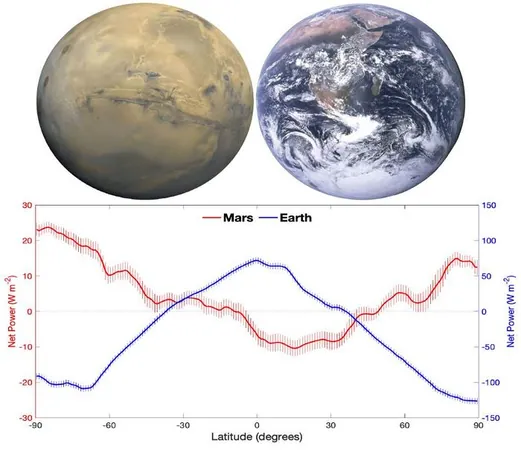
Unlocking Mars' Secrets: How Radiant Energy is Shaping Dust Storms and Climate Evolution
2025-01-07
Author: Mei
Introduction
Recent groundbreaking research has revealed fascinating insights into Martian weather patterns and their potential links to Earth's climate systems. An international team of scientists recently conducted a pioneering analysis of Mars' Radiant Energy Budget (REB), providing critical data on how solar energy impacts the Red Planet's atmospheric behavior—particularly concerning the notorious global dust storms that challenge our robotic explorers and future human missions.
Focus of the Study
The study, published in AGU Advances, focuses on understanding the REB, which measures both the incoming solar energy and the outgoing thermal energy across planetary surfaces. Utilizing data from the Mars Global Surveyor Thermal Emission Spectrometer (MGS-TES), combined with NASA's Clouds and the Earth's Radiant Energy System (CERES) Energy Balanced and Filled (EBAF) project, the researchers meticulously measured REB at various latitudes and seasonal cycles of Mars.
Key Findings
What they discovered was a striking contrast between the REB behaviors on Mars and Earth. On Earth, tropical regions typically experience an energy surplus while polar areas show an energy deficit, whereas Mars displays an opposite pattern. The energy surplus in the southern hemisphere of Mars appears to trigger the periodic global dust storms, which are known to play a significant role in altering Martian weather patterns.
Insights from Researchers
Larry Guan, a graduate student in the Department of Physics at the University of Houston and the study's lead author, pointed out that “the interaction between dust storms and the REB, along with polar ice dynamics, unveils the complex feedback processes likely influencing Martian weather patterns and long-term climate stability.”
Significance of Dust Storms
The impact of these dust storms cannot be overstated; they not only present obstacles to rover operations—such as the unfortunate end of the NASA Opportunity rover's mission—but also serve as a key indicator of Martian climate changes over time. As the researchers look ahead, they plan to delve deeper into the long-term implications that the REB might have on Mars' weather and climate evolution.
Conclusion
The implications of this study are profound, opening new avenues of inquiry into how Martian weather works and how it compares to our own climatic systems. What other mysteries will the Red Planet reveal in the years to come? The excitement of scientific discovery continues to drive explorations on Mars, reminding us of the importance of our quest to understand the universe.
Future Outlook
Stay tuned for future revelations about Mars and keep looking up! Who knows what the next groundbreaking study will uncover?

 Brasil (PT)
Brasil (PT)
 Canada (EN)
Canada (EN)
 Chile (ES)
Chile (ES)
 Česko (CS)
Česko (CS)
 대한민국 (KO)
대한민국 (KO)
 España (ES)
España (ES)
 France (FR)
France (FR)
 Hong Kong (EN)
Hong Kong (EN)
 Italia (IT)
Italia (IT)
 日本 (JA)
日本 (JA)
 Magyarország (HU)
Magyarország (HU)
 Norge (NO)
Norge (NO)
 Polska (PL)
Polska (PL)
 Schweiz (DE)
Schweiz (DE)
 Singapore (EN)
Singapore (EN)
 Sverige (SV)
Sverige (SV)
 Suomi (FI)
Suomi (FI)
 Türkiye (TR)
Türkiye (TR)
 الإمارات العربية المتحدة (AR)
الإمارات العربية المتحدة (AR)